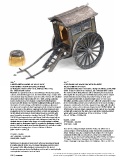Page 240 - Japanese Art Nov 9 2017 London
P. 240
390
390 * 391 *
A MIXED-METAL MODEL OF AN OX-CART, A RECTANGULAR WOOD BOX WITH EN-SUITE
CONTAINING A KORO (INCENSE-BURNER) INLAID-SHIBUICHI COVER
By Nakagawa Joeki IX (1849-1911), Meiji era (1868-1912), By Sekiguchi Ichiya (1850-1933) after a design by Shibata Zeshin, Meiji
late 19th/early 20th century (1868-1912) or Taisho (1912-1926) era, late 19th/early 20th century
Modelled as a gissha (courtly ox-cart) with large wheels, long poles, The inrobuta (flush-fitting lid) inset with a shibuichi panel engraved in
curtains, detachable hipped roof, and detachable steps, mostly made kebori (plain line engraving) and katakiribori (engraving with an angled
from shakudo alloy decorated in gold and silver, the roof with chiselled chisel emulating brushstrokes), decorated in inlays of silver, gold
decoration in silver representing two ho-o birds among paulownia and copper flat relief with an autumnal night scene of ‘The Foxes’
leaves and blossoms, the shakudo components imitating black Wedding’, depicting a procession of foxes attired in samurai dress, two
lacquer and with flowers and tendrils in gilding imitating gold lacquer, at the front holding a lantern and a halberd, five at the back carrying a
the interior of both carriage and lid gilded; containing a gilt-metal palanquin containing the fox bride, signed at lower right with chiselled
koro (incense burner) and silver hoya (pierced lid) of lobed rectangular characters Zeshin-o hitsui Jitokusai Ichiya koku 是真翁筆意自得斎一也
form, each side of the gilt koro engraved with chrysanthemum and 刻 (carved by Jitokusai Ichiya copying the brush style of the venerable
paulownia crests, the hoya pierced with ho-o birds and paulownia; Zeshin) with a gold seal; the sides, base and interior of plain polished
the lid signed inside Kyusei Joeki tsukuru (made by Joeki IX); with wood, with a wood storage box. 5.2cm x 14.8cm x 11.7cm
wood tomobako storage box inscribed by Joeki X (Shoshin, 1880- (2in x 5 13/16in x 4 9/16in). (3).
1940) Udo goshoguruma koro migi Kyusei Joeki saku utagai naki no
mono nari Showa tsuchinoe-tatsu santo Nakagawa Joeki shiki (This £2,000 - 3,000
shakudo incense-burner in the shape of a court carriage is without JPY300,000 - 440,000
doubt a work by Nakagawa Joeki IX, recorded by Nakagawa Joeki [X], US$2,600 - 4,000
winter 1928) and sealed Jusei Shoshin (Shoshin, X); and with a further
inscribed wood storage box. 23.5cm x 16.6cm x 38.6cm Born in Edo, Sekiguchi Ichiya worked in Tokyo, his father was a
(9¼in x 6½in x 15¼in). (7). samurai retainer of the Matsudaira family. Adopted by Sugioka Ikken
£12,000 - 18,000 (1832-1904), he was also a student of Goto Ichijo (1791-1876) and
JPY1,800,000 - 2,700,000 collaborated with Ichijo on some pieces. Ichiya’s last student and
US$16,000 - 24,000 adopted son was the fourth Kashima Ikkoku (1898-1979), see Robert
E. Haynes, The Index of Japanese Sword Fittings and Associated
Artists, Ellwangen, Germany, Nihon Art Publishers, 2001, no.H01743.
Ninth head of a lineage of Kyoto artists who had specialized mainly
in making utensils for the tea ceremony, Nakagawa Joeki received
the support of the Mitsui family to compensate for the loss of
traditional patronage during the Meiji era and turned to creating highly
accomplished ornaments such as this lot.
238 | BONHAMS For details of the charges payable in addition to the final Hammer Price of each Lot
please refer to paragraphs 7 & 8 of the Notice to Bidders at the back of the catalogue.

